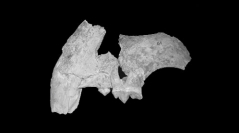

 Comptes Rendus Palevol
7 (8) - Pages 601-606
Comptes Rendus Palevol
7 (8) - Pages 601-606A partial skull and articulated postcranial elements of Megantereon whitei have been recorded during the 1950s from a karst deposit in the Monte Argentario area (Grosseto). These fossils recently became available for study. The bones are quite well preserved, included in a hard reddish matrix with calcareous clasts. The fossil is part of a faunal assemblage referred to the Late Villafranchian (Early Pleistocene). M. whitei from Monte Argentario is characterised by elongated upper canines, stronger than those of the Upper Valdarno (Tuscany) specimens and similar to the Pirro Nord (Apulia) fossil. The manus is robust, the first phalanges are quite long in comparison to the metacarpals. The Early Pleistocene European M. whitei represents an African element that took part in the faunal dispersal from Africa to Europe that occurred at the Plio-Pleistocene transition.
Megantereon, Plio-Pleistocene, Villafranchian, Africa, Europe, Italy, Dispersal event